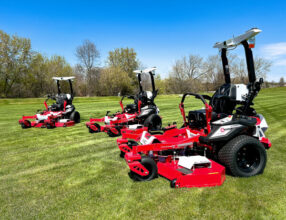OPEI Living Landscapes Matter program educates public on benefits of green spaces
By Kris Kiser
As the western part of the United States experiences one of the historically worst droughts (and other parts of the country flood), everyone seems to be pointing fingers to the culprit. Global warming? Natural weather cycle? Population growth?
Unfortunately, in the mad dash to deal with extreme weather conditions, the managed landscape has come under attack. Labeled as a “water waster,” the environmental, aesthetic and lifestyle benefits that manmade green spaces provide are being discounted, devalued, and undermined by policymakers and concerned citizens. Though well intentioned, these actions have dire consequences.
In the rush to save water, damaging programs and policies have been introduced, especially in California, such as rebate programs encouraging people to “rip out” their lawns and to deaden their landscapes with rocks, mulch and artificial turf. We know that over time, these actions will lead to detrimental environmental impacts like increased heat island effect, poorer air quality, additional storm runoff, and increased soil erosion — not to mention loss of lifestyle and aesthetic enjoyment. Without green spaces to maintain, use of outdoor power equipment and landscaping services also diminish.
THE SOLUTION
The Living Landscapes Matter program, launched in the summer of 2015 by the Outdoor Power Equipment Institute (OPEI), promotes the benefits of living plants, grasses, shrubs and trees, while demonstrating that it is possible to have a drought-friendly yard. Homeowners and municipalities can have living yards, parks, recreational fields and other community green spaces and be good environmental stewards.
Dealers, manufacturers, landscape industry professionals and other industry members are invited to access OPEI’s growing library of information and resources on the association’s stewardship webpage at http://opei.org/stewardship/. These free resources support you in educating customers and other stakeholders on the environmental and cultural value and benefits of a managed green space, removing myths, and arming homeowners and customers against drought-shaming and other acts against having a living landscape.
Access these materials and more today:

* Infographics. “Living Landscapes Matter” is a scientific-based infographic (see Figure 1) and “TurfMutt Barks for Living Landscapes” is a fun visual depiction of the environmental benefits of landscapes. They are in .jpeg format for easy online distribution via email and social media and for posting on your website.
* Fact sheets. Share the environmental and lifestyle benefits of a living landscape with local media, on your website or blog, and with customers.
* Blog posts. Customize or post “as is” to your business blog, web page or Facebook page. Some have pre-written tweets to accompany them.
* Radio interviews. These short audio files are perfect for sharing and posting on websites and through social media.
* Independent resources. These third-party resources and information provide backup and credibility to the scientific arguments for living landscapes.
* USDA Plant Hardiness Zone Map (under independent resources). Fielding questions about appropriate landscape options starts with understanding one’s climate zone. This map (located at http://planthardiness.ars.usda.gov/PHZMWeb/) helps consumers understand where they live and how that impacts what plants, shrubs, trees and grasses may be appropriate for their climate zone.
GRASS GRATITUDE: 7 REASONS WHY GRASS IS AWESOME
Even if you work in the outdoor power equipment industry, you may not know that the grass beneath your feet offers amazing benefits for your family and community. OPEI shares seven reasons to thank your lucky stars that grass is part of our living landscapes today:
* Reason #1: Our lawns are incredible oxygen-making machines, and they cleanse the air too! A grass area measuring 50 feet by 50 feet will produce enough oxygen to meet the daily needs of a family of four. Research has also shown that turfgrass removes atmospheric pollutants such as carbon dioxide, ozone, hydrogen fluoride, and perosyzacetyle nitrate from the air. Grass also plays a vital role in capturing dust, smoke particles and other pollutants that harm people.
* Reason #2: Your grass cools down your community and the area around your home. This is especially important in cities, where asphalt, hardscape and the growing use of plastic turf radiate heat. Grass dissipates this radiant heat through a process called evapotranspiration, which combats the heat island effect.
* Reason #3: Your lawn combats climate change. Grass is the largest carbon sink in the country, absorbing the greenhouse gas carbon dioxide that is warming up our planet. An average-sized home lawn has the potential to sequester 20.3 to 163.4 kg. C per lawn per year. The dense canopy and fibrous root system in your lawn sequesters carbon so well, that it outweighs the carbon used for maintaining the grass by as much as seven-fold.
* Reason #4: Your lawn helps control water runoff and erosion. Grass acts like a sponge and prevents water from “running off” into area sewer drains and carrying anything it collects along the way — like motor oil, dirt or trash. Grass cleans the water it collects and breaks down harmful microbes and pollutants, keeping them out of groundwater supplies. The natural filtration system in your lawn is so effective that rainwater filtered through a healthy lawn is often as much as 10 times less acidic than water running off a hard surface like a sidewalk or hardscape. It also prevents flooding and soil erosion by “hanging on” to soil.
* Reason #5: Grass reduces noise. Grass cuts down on excessive sound, a growing problem in urban areas, where hardscape and pavement reverberate noise. Grass slopes alongside lowered expressways reduce noise 8-10 decibels.
* Reason #6: Your lawn can make you happier. Research shows that knowing and experiencing nature, including grass, makes us generally happier, healthier people. Studies show that even just looking out a window at green spaces can lower adult stress levels. Walking or running in green spaces, instead of synthetic environments, led to decreased anger, fatigue and feelings of depression, while increasing attention levels.
* Reason #7: Your children and pets benefit from your lawn. A useable outdoor area provides a safe area for children and pets to play, while providing a spacious living area for the entire family. Outdoor play increases fitness levels and builds active, healthy bodies — an important strategy in helping the one in three American kids who are obese get fit. Research also shows that children’s stress levels fall within minutes of seeing green spaces.
To learn more about OPEI’s Living Landscapes Matter program and download free materials you can use, go to http://opei.org/stewardship/.
 Kris Kiser is the president and CEO of the Outdoor Power Equipment Institute (OPEI). For more information about OPEI, visit http://opei.org.
Kris Kiser is the president and CEO of the Outdoor Power Equipment Institute (OPEI). For more information about OPEI, visit http://opei.org.



